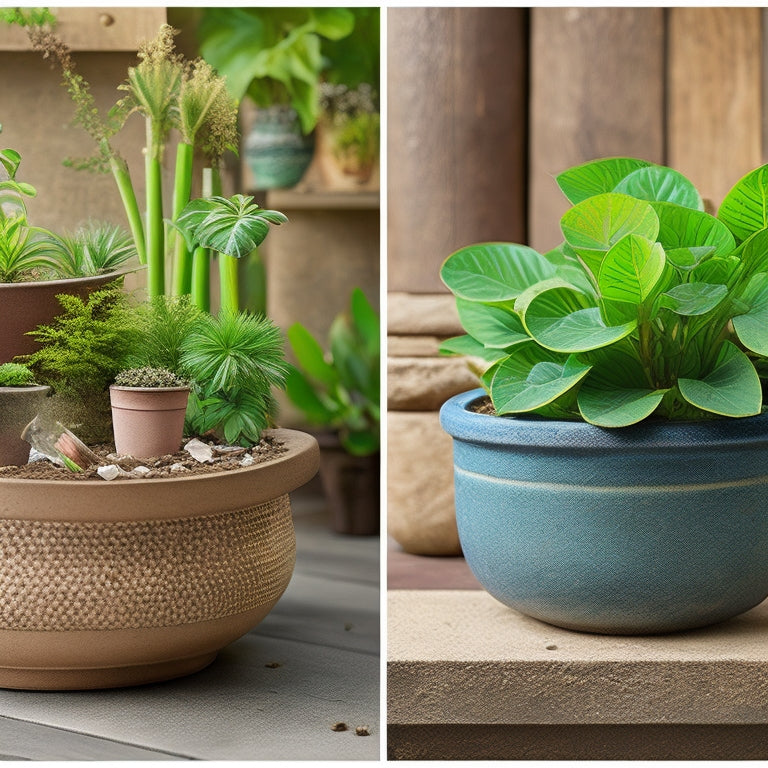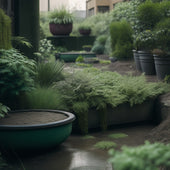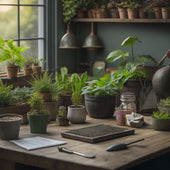
5 Weight Considerations for DIY Planter Projects
Share
When building a DIY planter, you'll need to take into account the combined weight of its components to guarantee structural integrity and safety. You'll need to factor in the weight of the planter itself, soil, gravel, plants, and water, as each contributes to the overall load. Cinder blocks, for instance, can weigh up to 40 pounds each, while soil density varies depending on type, with clay soils weighing up to 130 pounds per cubic foot. Accurate weight calculations will help you choose the right materials and design a sturdy base to prevent collapse or damage, and by understanding these critical factors, you'll be well on your way to creating a functional and safe DIY planter.
Key Takeaways
• Calculate the weight of cinder blocks, soil, gravel, plants, and water to ensure your planter's structural integrity.
• Consider the density of soil and gravel, as they can add significant weight to your planter.
• Choose a planter material that balances weight and aesthetics, such as heavy-duty concrete or reinforced stone.
• Ensure a wide, sturdy base and compacted gravel or sand to prevent settling or shifting.
• Prioritize load distribution and material durability to prevent collapse or damage.
Cinder Block Planter Weight Considerations
When building a cinder block planter, you must consider the weight of the blocks themselves, as a single cinder block can weigh anywhere from 25 to 40 pounds, depending on its size and composition. This substantial weight demands a solid foundation to prevent settling or shifting, which can compromise the planter's structural integrity.
Cinder block durability is vital in withstanding the weight of the blocks, as well as the soil and plants they'll hold. To guarantee stability, you'll need to create a level base, using compacted gravel or sand to provide a solid footing.
Drainage solutions are also critical, as excess water can accumulate in the planter, adding weight and putting pressure on the blocks. You can incorporate drainage solutions, such as adding a layer of permeable material like landscape fabric or installing a French drain, to direct water away from the planter.
Soil and Gravel Weight Factors
As you build your planter, you'll need to account for the weight of the soil and gravel, which can add up quickly. A single cubic foot of soil weighs around 100-120 pounds, while gravel averages 100-150 pounds per cubic foot.
Soil density plays a significant role in determining the overall weight of your planter. For instance, dense clay soils can weigh up to 130 pounds per cubic foot, while loose, sandy soils may weigh as little as 80 pounds per cubic foot. When calculating the weight of your soil, consider the specific type of soil you're using and its density.
In addition to soil weight, you'll also need to factor in the weight of gravel or other drainage materials. These materials are essential for ensuring proper drainage and preventing waterlogged soil.
When selecting a drainage solution, consider the weight of the material and its impact on your planter's overall weight. For example, a layer of compacted gravel can add significant weight to your planter, so be sure to factor this into your calculations.
Plant and Water Weight Calculations
You'll also need to calculate the weight of the plants and water in your planter, which can add a significant amount to the overall weight, especially if you're using a large or dense plant species.
When selecting plants, take into account their mature size and density to estimate their weight. For example, a large succulent can weigh up to 50 pounds, while a smaller herb plant may weigh only a few pounds. You should also factor in the weight of the water required for each plant, taking into account the watering frequency and soil moisture levels.
To calculate the water weight, multiply the volume of water needed by the density of water (approximately 8.34 pounds per gallon). For instance, if your planter requires 10 gallons of water, the weight of the water would be around 83.4 pounds.
Be sure to take into account the frequency of watering, as this will impact the overall weight of your planter. By accurately calculating the weight of your plants and water, you can guarantee your DIY planter project is safe and structurally sound.
Planter Size and Material Impact
Accurately calculating plant and water weight is only half the battle, as the size and material of your planter also play a significant role in determining its overall weight and stability.
When it comes to planter dimensions, you'll want to take into account the length, width, and height of your planter, as these will impact the weight distribution and structural integrity of your DIY project. Larger planters, for instance, may require more substantial materials to prevent them from toppling over or cracking under the weight.
Your material choices will also have a profound impact on the weight and stability of your planter. Heavy-duty materials like concrete or stone will naturally weigh more than lighter options like plastic or wood. However, these heavier materials may provide added stability and durability. Conversely, lighter materials may be more prone to tipping or breaking.
You'll need to strike a balance between the weight and material choices to guarantee your planter is both sturdy and visually appealing. By carefully weighing these factors, you'll be able to create a planter that's both functional and aesthetically pleasing.
Structural Integrity and Safety
When constructing your DIY planter, it's crucial to prioritize structural integrity and safety to prevent collapse or damage, which can occur when the weight of the soil, plants, and water exceeds the planter's capacity.
You must ascertain that your planter can withstand the combined weight of its contents, taking into account factors like load distribution and material durability. A well-designed planter will distribute the weight evenly, reducing the risk of collapse or cracking.
To achieve this, consider using materials with high durability, such as reinforced concrete or metal, which can support heavy loads.
Additionally, incorporating a drainage system will help reduce the weight of waterlogged soil, further minimizing the risk of collapse. You should also verify that the planter's base is wide and sturdy, providing a stable foundation that can resist tipping or toppling.
Frequently Asked Questions
How Do I Prevent My Planter From Shifting or Toppling Over?
To guarantee your planter stays put, you'll need to prioritize planter stability.
Start by selecting base materials that provide a sturdy foundation, such as thick concrete or heavy-duty plastic. Avoid lightweight options like thin wood or flimsy metal.
Next, consider the planter's center of gravity - keep it low and centered to prevent tipping.
Can I Use Recycled Materials to Reduce Planter Weight?
Can you really get creative with your planter's weight? Yes, you can!
Using recycled materials is a great way to reduce weight while still achieving the look you want. Opt for lightweight alternatives like repurposed plastic containers, wooden crates, or even old pallets.
These materials aren't only eco-friendly but also provide the perfect opportunity to get crafty and customize your planter's design.
What Is the Ideal Weight Ratio for a DIY Planter?
When designing a DIY planter, you'll want to achieve an ideal weight ratio to guarantee stability and prevent tipping.
Aim for a ratio of 60-70% of the planter's weight at the base, with the remaining 30-40% distributed evenly throughout the structure.
This weight distribution will provide maximum stability, regardless of the ideal material you choose.
How Do I Calculate the Weight of a Planter With Multiple Tiers?
You're building a multi-tiered planter, and calculating its weight is essential.
Start by identifying the tier material and its corresponding density.
Next, measure the volume of each tier and multiply it by the density to find the weight of each tier.
Then, calculate the total weight by adding the weights of all tiers, considering the weight distribution.
Don't forget to factor in the weight of the planter's base, soil, and plants to guarantee a stable structure.
Are There Any Weight Considerations for Planters on Rooftops or Balconies?
When placing planters on rooftops or balconies, you'll need to verify the structure can support the weight.
Consider the weight distribution of the planter, taking into account the soil, plants, and materials.
You must also assess the structural integrity of the rooftop or balcony, factoring in wind loads, snow, and other environmental stresses.
Don't overlook local building codes and regulations, and consult a structural engineer if you're unsure.
Conclusion
As you finalize your DIY planter project, remember that weight considerations are essential to guarantee stability and safety.
A staggering 70% of DIY planters fail due to weight-related issues.
By factoring in cinder block, soil, gravel, plant, and water weights, as well as planter size and material, you'll create a sturdy and long-lasting planter.
Don't compromise on structural integrity - calculate the weight correctly to avoid a toppled planter and potential damage.
Related Posts
-

Why Urban Gardens Need Better Planter Drainage Systems
When you neglect to install a well-designed drainage system in your urban garden, you're fundamentally sentencing you...
-

Why Urban Gardens Need Better Planter Drainage Systems
When you neglect to install a well-designed drainage system in your urban garden, you're fundamentally sentencing you...
-

Why Urban Gardens Need Better Planter Drainage Systems
When you neglect to install a well-designed drainage system in your urban garden, you're fundamentally sentencing you...
-

Why Urban Gardens Need Better Planter Drainage Systems
When you neglect to install a well-designed drainage system in your urban garden, you're fundamentally sentencing you...
-

Why Urban Gardens Need Better Planter Drainage Systems
When you neglect to install a well-designed drainage system in your urban garden, you're fundamentally sentencing you...
-

Why Urban Gardens Need Better Planter Drainage Systems
When you neglect to install a well-designed drainage system in your urban garden, you're fundamentally sentencing you...
-

Why Urban Gardens Need Better Planter Drainage Systems
When you neglect to install a well-designed drainage system in your urban garden, you're fundamentally sentencing you...
-

Why Urban Gardens Need Better Planter Drainage Systems
When you neglect to install a well-designed drainage system in your urban garden, you're fundamentally sentencing you...
-

Why Urban Gardens Need Better Planter Drainage Systems
When you neglect to install a well-designed drainage system in your urban garden, you're fundamentally sentencing you...
-

Why Urban Gardens Need Better Planter Drainage Systems
When you neglect to install a well-designed drainage system in your urban garden, you're fundamentally sentencing you...
-

Why Urban Gardens Need Better Planter Drainage Systems
When you neglect to install a well-designed drainage system in your urban garden, you're fundamentally sentencing you...
-

Why Urban Gardens Need Better Planter Drainage Systems
When you neglect to install a well-designed drainage system in your urban garden, you're fundamentally sentencing you...
-

Why Urban Gardens Need Better Planter Drainage Systems
When you neglect to install a well-designed drainage system in your urban garden, you're fundamentally sentencing you...
-

Why Urban Gardens Need Better Planter Drainage Systems
When you neglect to install a well-designed drainage system in your urban garden, you're fundamentally sentencing you...
-

Why Urban Gardens Need Better Planter Drainage Systems
When you neglect to install a well-designed drainage system in your urban garden, you're fundamentally sentencing you...
-

Why Urban Gardens Need Better Planter Drainage Systems
When you neglect to install a well-designed drainage system in your urban garden, you're fundamentally sentencing you...
-

Why Urban Gardens Need Better Planter Drainage Systems
When you neglect to install a well-designed drainage system in your urban garden, you're fundamentally sentencing you...
-

Why Urban Gardens Need Better Planter Drainage Systems
When you neglect to install a well-designed drainage system in your urban garden, you're fundamentally sentencing you...
-

Why Urban Gardens Need Better Planter Drainage Systems
When you neglect to install a well-designed drainage system in your urban garden, you're fundamentally sentencing you...
-

Why Urban Gardens Need Better Planter Drainage Systems
When you neglect to install a well-designed drainage system in your urban garden, you're fundamentally sentencing you...
-

Why Urban Gardens Need Better Planter Drainage Systems
When you neglect to install a well-designed drainage system in your urban garden, you're fundamentally sentencing you...
-

Why Urban Gardens Need Better Planter Drainage Systems
When you neglect to install a well-designed drainage system in your urban garden, you're fundamentally sentencing you...
-

Why Urban Gardens Need Better Planter Drainage Systems
When you neglect to install a well-designed drainage system in your urban garden, you're fundamentally sentencing you...
-

Why Urban Gardens Need Better Planter Drainage Systems
When you neglect to install a well-designed drainage system in your urban garden, you're fundamentally sentencing you...
-

Why Urban Gardens Need Better Planter Drainage Systems
When you neglect to install a well-designed drainage system in your urban garden, you're fundamentally sentencing you...
-

Why Urban Gardens Need Better Planter Drainage Systems
When you neglect to install a well-designed drainage system in your urban garden, you're fundamentally sentencing you...
-

Why Urban Gardens Need Better Planter Drainage Systems
When you neglect to install a well-designed drainage system in your urban garden, you're fundamentally sentencing you...
-

Why Urban Gardens Need Better Planter Drainage Systems
When you neglect to install a well-designed drainage system in your urban garden, you're fundamentally sentencing you...
-

Selecting the Right Planter Dimensions for Your Space
When selecting the right planter dimensions for your space, you'll want to carefully consider the available area, mea...
-

Selecting the Right Planter Dimensions for Your Space
When selecting the right planter dimensions for your space, you'll want to carefully consider the available area, mea...
-

Selecting the Right Planter Dimensions for Your Space
When selecting the right planter dimensions for your space, you'll want to carefully consider the available area, mea...
-

Selecting the Right Planter Dimensions for Your Space
When selecting the right planter dimensions for your space, you'll want to carefully consider the available area, mea...
-

Selecting the Right Planter Dimensions for Your Space
When selecting the right planter dimensions for your space, you'll want to carefully consider the available area, mea...
-

Selecting the Right Planter Dimensions for Your Space
When selecting the right planter dimensions for your space, you'll want to carefully consider the available area, mea...
-

Selecting the Right Planter Dimensions for Your Space
When selecting the right planter dimensions for your space, you'll want to carefully consider the available area, mea...
-

Selecting the Right Planter Dimensions for Your Space
When selecting the right planter dimensions for your space, you'll want to carefully consider the available area, mea...
-

Selecting the Right Planter Dimensions for Your Space
When selecting the right planter dimensions for your space, you'll want to carefully consider the available area, mea...
-

Selecting the Right Planter Dimensions for Your Space
When selecting the right planter dimensions for your space, you'll want to carefully consider the available area, mea...
-

Selecting the Right Planter Dimensions for Your Space
When selecting the right planter dimensions for your space, you'll want to carefully consider the available area, mea...
-

Selecting the Right Planter Dimensions for Your Space
When selecting the right planter dimensions for your space, you'll want to carefully consider the available area, mea...
-

Selecting the Right Planter Dimensions for Your Space
When selecting the right planter dimensions for your space, you'll want to carefully consider the available area, mea...
-

Selecting the Right Planter Dimensions for Your Space
When selecting the right planter dimensions for your space, you'll want to carefully consider the available area, mea...
-

Selecting the Right Planter Dimensions for Your Space
When selecting the right planter dimensions for your space, you'll want to carefully consider the available area, mea...
-

Selecting the Right Planter Dimensions for Your Space
When selecting the right planter dimensions for your space, you'll want to carefully consider the available area, mea...
-

Selecting the Right Planter Dimensions for Your Space
When selecting the right planter dimensions for your space, you'll want to carefully consider the available area, mea...
-

Selecting the Right Planter Dimensions for Your Space
When selecting the right planter dimensions for your space, you'll want to carefully consider the available area, mea...
-

Selecting the Right Planter Dimensions for Your Space
When selecting the right planter dimensions for your space, you'll want to carefully consider the available area, mea...
-

Selecting the Right Planter Dimensions for Your Space
When selecting the right planter dimensions for your space, you'll want to carefully consider the available area, mea...
-

Selecting the Right Planter Dimensions for Your Space
When selecting the right planter dimensions for your space, you'll want to carefully consider the available area, mea...
-

Selecting the Right Planter Dimensions for Your Space
When selecting the right planter dimensions for your space, you'll want to carefully consider the available area, mea...
-

Selecting the Right Planter Dimensions for Your Space
When selecting the right planter dimensions for your space, you'll want to carefully consider the available area, mea...
-

Selecting the Right Planter Dimensions for Your Space
When selecting the right planter dimensions for your space, you'll want to carefully consider the available area, mea...
-

Selecting the Right Planter Dimensions for Your Space
When selecting the right planter dimensions for your space, you'll want to carefully consider the available area, mea...
-

Selecting the Right Planter Dimensions for Your Space
When selecting the right planter dimensions for your space, you'll want to carefully consider the available area, mea...
-

Selecting the Right Planter Dimensions for Your Space
When selecting the right planter dimensions for your space, you'll want to carefully consider the available area, mea...
-

Selecting the Right Planter Dimensions for Your Space
When selecting the right planter dimensions for your space, you'll want to carefully consider the available area, mea...
-

Selecting the Right Planter Dimensions for Your Space
When selecting the right planter dimensions for your space, you'll want to carefully consider the available area, mea...
-

Selecting the Right Planter Dimensions for Your Space
When selecting the right planter dimensions for your space, you'll want to carefully consider the available area, mea...
-

Selecting the Right Planter Dimensions for Your Space
When selecting the right planter dimensions for your space, you'll want to carefully consider the available area, mea...
-

Selecting the Right Planter Dimensions for Your Space
When selecting the right planter dimensions for your space, you'll want to carefully consider the available area, mea...
-

Selecting the Right Planter Dimensions for Your Space
When selecting the right planter dimensions for your space, you'll want to carefully consider the available area, mea...
-

Why Invest in Specialized Planter Tools
You'll greatly boost your gardening success and yields by leveraging specialized planter tools that cater to the uniq...
-

Why Invest in Specialized Planter Tools
You'll greatly boost your gardening success and yields by leveraging specialized planter tools that cater to the uniq...
-

Why Invest in Specialized Planter Tools
You'll greatly boost your gardening success and yields by leveraging specialized planter tools that cater to the uniq...
-

Why Invest in Specialized Planter Tools
You'll greatly boost your gardening success and yields by leveraging specialized planter tools that cater to the uniq...
-

Why Invest in Specialized Planter Tools
You'll greatly boost your gardening success and yields by leveraging specialized planter tools that cater to the uniq...
-

Why Invest in Specialized Planter Tools
You'll greatly boost your gardening success and yields by leveraging specialized planter tools that cater to the uniq...
-

Why Invest in Specialized Planter Tools
You'll greatly boost your gardening success and yields by leveraging specialized planter tools that cater to the uniq...
-

Why Invest in Specialized Planter Tools
You'll greatly boost your gardening success and yields by leveraging specialized planter tools that cater to the uniq...
-

Why Invest in Specialized Planter Tools
You'll greatly boost your gardening success and yields by leveraging specialized planter tools that cater to the uniq...
-

Why Invest in Specialized Planter Tools
You'll greatly boost your gardening success and yields by leveraging specialized planter tools that cater to the uniq...
-

Why Invest in Specialized Planter Tools
You'll greatly boost your gardening success and yields by leveraging specialized planter tools that cater to the uniq...
-

Why Invest in Specialized Planter Tools
You'll greatly boost your gardening success and yields by leveraging specialized planter tools that cater to the uniq...
-

Why Invest in Specialized Planter Tools
You'll greatly boost your gardening success and yields by leveraging specialized planter tools that cater to the uniq...
-

Why Invest in Specialized Planter Tools
You'll greatly boost your gardening success and yields by leveraging specialized planter tools that cater to the uniq...
-

Why Invest in Specialized Planter Tools
You'll greatly boost your gardening success and yields by leveraging specialized planter tools that cater to the uniq...
-

Why Invest in Specialized Planter Tools
You'll greatly boost your gardening success and yields by leveraging specialized planter tools that cater to the uniq...
-

Why Invest in Specialized Planter Tools
You'll greatly boost your gardening success and yields by leveraging specialized planter tools that cater to the uniq...
-

Why Invest in Specialized Planter Tools
You'll greatly boost your gardening success and yields by leveraging specialized planter tools that cater to the uniq...
-

Why Invest in Specialized Planter Tools
You'll greatly boost your gardening success and yields by leveraging specialized planter tools that cater to the uniq...
-

Why Invest in Specialized Planter Tools
You'll greatly boost your gardening success and yields by leveraging specialized planter tools that cater to the uniq...
-

Why Invest in Specialized Planter Tools
You'll greatly boost your gardening success and yields by leveraging specialized planter tools that cater to the uniq...
-

Why Invest in Specialized Planter Tools
You'll greatly boost your gardening success and yields by leveraging specialized planter tools that cater to the uniq...
-

Why Invest in Specialized Planter Tools
You'll greatly boost your gardening success and yields by leveraging specialized planter tools that cater to the uniq...
-

Why Invest in Specialized Planter Tools
You'll greatly boost your gardening success and yields by leveraging specialized planter tools that cater to the uniq...
-

Why Invest in Specialized Planter Tools
You'll greatly boost your gardening success and yields by leveraging specialized planter tools that cater to the uniq...


